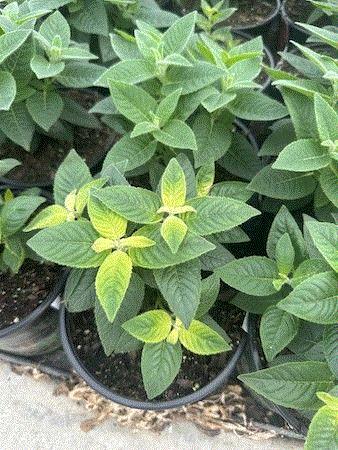Let's Remember, and Then a Challenge

I hope you had a great Memorial Day Weekend. Before diving into this week’s newsletter, I’d first like to honor those who gave their lives fighting for our freedom, and give thanks to the veterans that have served and those who are currently actively serving in the military. We wouldn’t be where we are today without each and every one of you. God bless the USA.
What's Happening Here?
Shifting gears, let’s move on to a diagnostic challenge. Check this out:
Do you see the yellow appearance on this monarda? Unless this is a new variety, I’d say the yellow coloration on the new growth is definitely not supposed to be there. You’ll likely find this image a little peculiar or perhaps all too familiar.
Is the yellow being caused by a nutritional disorder, spray damage, virus, pollution, herbicide injury or by something else? It’s time for me to ask, “What’s happening here?" Enjoy the newsletter, I’ll reveal the answer before signing off for the week.
EpiShield Reprise
I first mentioned a new product called EpiShield from Bioworks, Inc. in the October 11 issue. It’s not often that I repeat content, especially when it comes to plant protection products. However, based on my recent experiences with it this spring, I couldn’t keep my lips sealed any longer.
If your recall, EpiShield contains a unique formulation that uses a synergistic blend of clove oil, peppermint oil and sodium lauryl sulfate.
Seeing is believing. Since I shared this information with you last fall, my team of growers has tried EpiShield in a number of scenarios and it performed wonderfully each time. We’ve used EpiShield as a quick knockdown for spider mites on tropicals, a general cover spray on numerous flowering and non-blooming annuals and perennials (no injury whatsoever—not even on open flowers), and as a cutting dip to control unwanted thrips on cuttings.
How does EpiShield deliver such good results? It has multiple modes of action and works on contact to generate pest paralysis, suffocation and desiccation. The excellent results combined with its incredibly high plant safety has our growers excited about this new insect management tool.

Perennial Palooza
I shared some summer trade events in the last issue and mentioned I would be pass along others in the future. You didn’t have to wait long. Here’s an event that’s likely not on your radar: Gardenworld’s Perennial Palooza.
Before I get to the event, many of you may be wondering who Gardenworld is. Gardenworld is a wholesale distributor of high-quality perennial starting materials to the industry marketed under the Growing Colors brand. They offer a wide variety of perennials as bareroot and in various plug/liner sizes. Go to their
WEBSITE to learn more about them and the products they offer.
Or better yet, attend their upcoming Perennial Palooza on June 27, 2024 in Cottage Grove, Minnesota. This is their Customer Appreciation Day. At Perennial Palooza attendees, will be able to:
-
Meet the Growing Colors team
-
Tour the facility—Greenhouse, warehouse, display garden and trial garden
-
Find out what’s new for 2025
-
See engaging growing demonstrations by their horticultural team
-
Share marketing ideas
-
Hear a talk from Paul Pilon (Hey, that’s me! I guess I better get working on it.)
-
Learn about their website
-
Enjoy food and have fun!
The event will be held during their normal business hours of 8:00 a.m. – 4:30 p.m. Central. Contact your Gardenworld sales representative or their office at
info@gardenworldinc.com with any questions or to RSVP for Gardenworld’s 2024 Perennial Palooza.

More June Trade Events
Some of these are just around the corner, but there’s still a little time to make arrangements or to fit them into your summer travel plans if you find yourself in these areas. Simply click on the title of the event names below to learn more about each of them.
|
June 4-5, 2024 |
Auburn, Alabama
|
|
June 4-6, 2024 |
Duluth, Georgia
|
|
June 5-6, 2024 |
Westminster, Maryland
|
|
June 6-7, 2024 |
Chicago, Illinois
|
|
June 15, 2024 |
Spokane, Washington
|
|
June 18, 2024 |
Zeeland, Michigan
|
|
June 19, 2024 |
West Chicago, Illinois
|
The Answer is ...

I shared this picture of monarda at the top of the newsletter and asked if you knew what was causing the yellow appearance. Before revealing the answer, take a look at the image below showing a larger perspective of the area.
See how the outside row is where the yellow plants are located? Do you have any ideas on why only the outside row would be affected? Let’s see if any other plants are showing similar symptoms.
Symptoms on achillea.
Looks like this grower is observing yellowing across multiple crops. Besides the monarda and achillea shown above, numerous perennials—including leucanthemum, perovskia, platycodon and salvia to name a few—are showing yellowing of the outside row of plants.
I bet you’ve probably locked in your answer to this challenge by now. If you answered herbicide injury, or more specifically glyphosate damage, you correctly solved this week’s challenge. This grower applied glyphosate (which is labeled for applications inside greenhouses) along the edge of the sidewalk, which is adjacent to the plants. Unfortunately, spray drift contacted the plants, resulting in injury or the yellow appearance.

Limiting Risk
There’s always risk when applying herbicides to and around crop areas. Let's talk briefly about ways to lessen crop injury from glyphosate applications.
First, not all herbicides containing glyphosate are labeled for applications within enclosed structures. The ones that have greenhouse applications on their labels limit applications to under benches, in walkways, around the foundation of the structure or to empty greenhouses (I prefer this option).
Use great care when applying glyphosate within greenhouses to ensure spray drift doesn't move over the crops being produced. Even small amounts of spray drift can cause significant injury to greenhouse crops.
Limiting Spray Drift
To reduce the potential for injury, only apply glyphosate inside EMPTY greenhouses. But if applications are made, follow these precautions.
-
Turn off horizontal air flow and exhaust fans while applications are being made and leave them off for a while following the applications.
-
Close vents and turn off exhaust fans when making applications outside the greenhouses.
-
Use a course spray at low pressure when applying glyphosate.
-
Use a protective cone around the spray nozzle and keep the nozzle just above the weeds being sprayed.
-
Only make applications to low-growing weeds when crops are present. This may require hand pulling any tall weeds before making the application.
-
Keep the nozzle inside the protective cone relatively close to the ground during the application. This minimizes the potential for spray drift.
Always refer to the herbicide label for proper application guidelines and restrictions before making applications within greenhouses. Deciding to use herbicides not labeled for use within a greenhouse could prove to be disastrous. Don’t take any unnecessary risks when it comes to herbicides.




Thanks for reading this edition of Perennial Pulse. My email is paul@opelgrowers.com if you have any comments, article suggestions or if you'd just like to say hello.
Best regards,

Paul Pilon
Editor-at-Large—Perennial Pulse
Director of Growing—Opel Growers
This email was received by you and 34,587 other fine subscribers!
If you're interested in advertising in Perennial Pulse, contact Kim Brown ASAP and she'll hook you up.